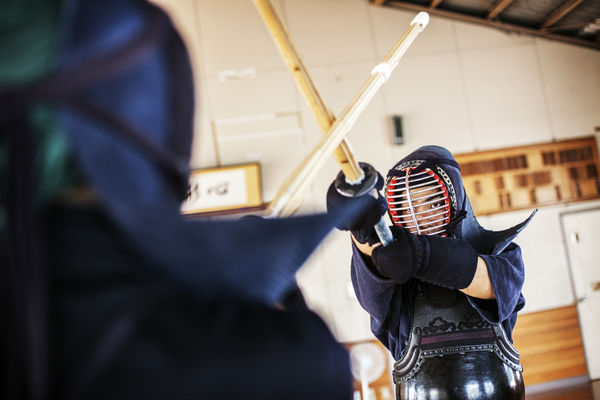Some history of Kendo martial art
Kendo has its origins in feudal Japan and means “Way of the Sword”. The Way of Sword was first mentioned under the name of kenjutsu in documents of ‘Hihon Shoki’ and ’em Kojiki’ in the 8th century. During this period, the country was divided into provinces, armies of military men were raised to defend them, and these armies were trained in the use of the longbow, horseback riding, sword and spear combat, and wrestling in full armor. However, this system was soon abandoned in favor of elite troops. Which later received a unique claim in terms of training and wading. The samurai class emerged.

In order to be able to select the best trained fighters, competitions were held regularly, and with the reputation gained there, the best fighters soon opened fencing schools in the larger cities. Here the students mostly trained with a wooden practice sword, the bokken. However, until the beginning of the 18th century, there was no consideration of protective equipment that could protect the exerciser from serious injury or even death during rigorous training with a sword.
How did Kendo develop?
At the beginning of the 18th century, Chuta Nakanishi, the founder of the Nakanishi Itto school, not only developed protective equipment, but also a practice sword made of bamboo slats in a leather sheath. It became possible for the students to practice full-strength punch techniques without injuring their counterparts with a sword. With the increasing popularity of the new training techniques, the spread of Kenjutsu also increased, not least due to the simplification of many traditional techniques and the general acceptance of certain rules of conduct within the training rooms.
Kendo quickly spread in Japan and in 1871 became part of physical training in all schools. After the events of World War II, the practice of Kendo was banned by the occupiers of Japan. Only in 1952, when a sports version of Kendo was developed, officially approved again and then included again in general school sports.
In 1953, Kendo was re-established, but no longer with the aim of learning survival techniques, but with the aim of strengthening character through the principles and methods of sword fighting.
What is the modern Kendo?
Kendo as a path not only pursues the techniques and tactics of sword fighting, but also the spiritual development of man. Above all, the practitioners should gain strength of character, determination and moral strength through Kendo.

As you can understand, today the sword is primarily regarded as an instrument for educating one’s mind and body. In hard training you learn techniques how to use the sword and thus how to deal with yourself and with your opponent. The concentration on the duel with the “opponent” and one’s own spirit makes up the actual basic idea of modern kendo today. This spiritual examination strengthens the unity of body and mind. At the same time, it trains the most important mental qualities such as self-confidence, willingness to make decisions, determination, but also respect and reverence. These qualities then gradually take up more and more space in life outside of training and thus form the character.
Kendo techniques are practiced very intensively in Japan today. Along with sumo and baseball, it’s arguably one of the most popular sports around. Kendo is very common alongside Judo as a school sport and university sport.
Are there any basics of gear?
The equipment of a kendoka consists primarily of the bamboo sword (shinai) and the armor (bogu).
Bogu:
The armor breaks down into four main parts: head protection (men); gloves (kote); breastplate (Do); Loin protection (tare).
The main material of the armor is a quilted cotton fabric and leather, which protects the body from blows. The Do is made of plastic in modern armor.
Shinai:
The shinai is a sword made of four bamboo struts. It is available in different sizes and weights, depending on the preference and stature of the kendoka. Due to its structure, sword is very flexible and absorbs part of the impact energy of a TreTer.
What are the main techniques?
Each workout begins with a warm-up, followed by compound exercises. In partner exercises we train Kendo techniques, all of which serve to prepare for the fight (Ji-Geiko).
The basic techniques with the partner can be trained with or without armor. Another feature why Kendo is also ideal for beginners who are not yet wearing armor.
Advanced techniques as well as Ji-Geiko require wearing the armor for the fighters (Kendoka) to be fully protected. It generally takes a few months of Neisse training to gain the experience needed to fight with the armor.
Are there any special requirements for judges?
The match is judged by 3 judges. They hold two flags – red and white – which match the colors of the ribbons attached to the backs of fencers. In the event of a successful reception by one of the athletes, the judge raises the flag corresponding to the color of his ribbon. If two of the three judges raise the flag, 1 point is awarded.
The referee has the right to stop the duel with the team “Pit!” (“Stop!”). He does this in the following cases:
- when the fencer, raising one hand, requires a time-out;
- when both fencers have long been in the position of crossed guards tsuba-zeriay;
- when one of the fencers fell;
- when there was a violation of the rules;
- when judges are about to rule on a contentious issue.
What is Kendo’s philosophy?
The basic definition of the concept of kendo as well as the approach to training and leadership are determined by the All-Japan Kendo Federation. The “way” in kendo is the way to improve a person, “forming” him as a person. It is impossible to become perfect, so it is the process – “formation” and improvement, and not the result – “formation” and perfection, that is one of the cornerstones of the philosophy of this martial art.

